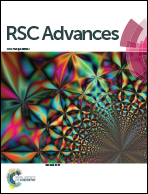Direct observation of electronic transition–plasmon coupling for enhanced electron injection in dye-sensitized solar cells
Abstract
We illustrate experimental evidence of the effect of surface plasmon resonance (SPR) of a noble metal on the ultrafast-electron injection efficiencies of a sensitizing dye in proximity of a wide band gap semiconductor. We have compared the effect of Au with Al nanoparticles as the former have a strong SPR band (peak 560 nm) at the emission (∼600 nm) of the model dye protoporphyrin IX (PP) in the proximity of mesoporous TiO2 nanoparticles in a model dye sensitized solar cell (DSSC). We have used detailed electron microscopic procedures for the characterization of Au/Al nanoparticle-embedded TiO2, the host of PP. Picosecond resolved emission spectroscopy on the model dye reveals an ultrafast component consistent with photoinduced electron transfer (PET) from the dye to the TiO2 matrix in the presence of Au nanoparticles. In order to investigate the dipolar separation of PP from the Au nanoparticle surface, we have employed a Förster Resonance Energy Transfer (FRET) strategy in the PP–Au nanoparticle system in the absence of TiO2. Although the time scale of FRET and PET were found to be similar, the plasmon induced enhanced electron transfer in the case of Au nanoparticles is found to be clear from various device parameters of the plasmonic solar cell (DSSC) designed from the materials. We have also fabricated a DSSC with the developed materials consisting of Al–Au nanoparticles with N719 dye as sensitizer. The fabricated DSSC exhibits a much higher power conversion efficiency of (7.1 ± 0.1)% compared to that with TiO2 alone (5.63 ± 0.13)%. The outstanding performance of DSSC based on plasmonic nanoparticles was attributed to the plasmonic coupling and scattering effect for enhanced electron injection efficiencies.


 Please wait while we load your content...
Please wait while we load your content...